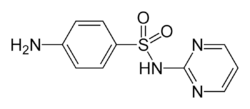Sulfadiazine
 | |
 | |
| Clinical data | |
|---|---|
| AHFS/Drugs.com | Monograph |
| MedlinePlus | a682130 |
| Pregnancy category |
|
| Routes of administration | Topical cream, oral |
| ATC code | J01EC02 (WHO) QJ01EQ10 (WHO) |
| Legal status | |
| Legal status |
|
| Pharmacokinetic data | |
| Bioavailability | ? |
| Metabolism | ? |
| Biological half-life | ? |
| Excretion | ? |
| Identifiers | |
| |
| CAS Number |
68-35-9 |
| PubChem (CID) | 5215 |
| DrugBank |
DB00359 |
| ChemSpider |
5026 |
| UNII |
0N7609K889 |
| KEGG |
D00587 |
| ChEMBL |
CHEMBL439 |
| ECHA InfoCard | 100.000.623 |
| Chemical and physical data | |
| Formula | C10H10N4O2S |
| Molar mass | 250.278 g/mol |
| Melting point | 252 to 256 °C (486 to 493 °F) |
| | |
Sulfadiazine is a sulfonamide antibiotic.
It is on the World Health Organization's List of Essential Medicines, the most important medications needed in a basic health system.[1]
Medical uses
It eliminates bacteria that cause infections by stopping the production of folate inside the bacterial cell, and is commonly used to treat urinary tract infections, and burns.
In combination, sulfadiazine and pyrimethamine, can be used to treat toxoplasmosis, a disease caused by Toxoplasma gondii.
Mechanism of action
Sulfadiazine works by inhibiting the enzyme dihydropteroate synthetase. In combination with pyrimethamine (a dihydrofolate reductase inhibitor), sulfadiazine is used to treat active toxoplasmosis.
Side effects
Side effects reported for sulfadiazine include: nausea, upset stomach, loss of appetite, and dizziness.
Brand names
Lantrisul; Neotrizine; Sulfa-Triple #2; Sulfadiazine; Sulfaloid; Sulfonamides Duplex; Sulfose; Terfonyl; Triple Sulfa; Triple Sulfas; Triple Sulfoid
See also
References
- ↑ "WHO Model List of EssentialMedicines" (PDF). World Health Organization. October 2013. Retrieved 22 April 2014.